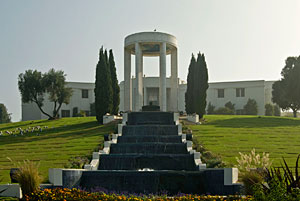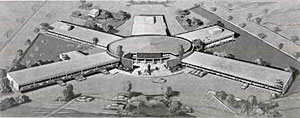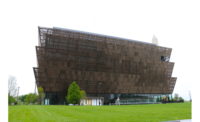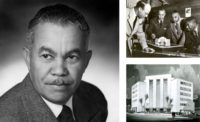Paul Revere Williams is synonymous with Golden-Age Los Angeles, helping to transform the Western outpost into a glamorous metropolis. The architect, who died in 1980, designed numerous homes for Beverly Hills and Hollywood luminaries. He was lauded for his domestically scaled interior design of the expanded Saks Fifth Avenue at 9600 Wilshire Boulevard, and for his $3 million, 11-year renovation of a nine-story French Renaissance apartment house into the famous Beverly Wilshire Hotel. His work spanned from local YMCA buildings to LAX, for which he was a member of the airport’s joint-venture design team.

Williams’s accomplishments were made even more impressive by this fact: In 1923, a year after opening his own firm, Williams became the first documented African-American member of the American Institute of Architects. He also was the first African American to become a Fellow of the AIA.Paul Revere Williams is synonymous with Golden-Age Los Angeles, helping to transform the Western outpost into a glamorous metropolis. The architect, who died in 1980, designed numerous homes for Beverly Hills and Hollywood luminaries. He was lauded for his domestically scaled interior design of the expanded Saks Fifth Avenue at 9600 Wilshire Boulevard, and for his $3 million, 11-year renovation of a nine-story French Renaissance apartment house into the famous Beverly Wilshire Hotel. His work spanned from local YMCA buildings to LAX, for which he was a member of the airport’s joint-venture design team.
On February 18, Williams’s birthday, the University of Memphis officially launched the Paul R. Williams Project in collaboration with the Memphis chapter of the AIA and the Memphis chapter of the National Organization of Minority Architects. This initiative aims to increase awareness about the pioneering architect through various means. “Like any great architect, we should all have the benefit of access to and knowledge of his work,” says Steven Lewis, AIA, president of the National Organization of Minority Architects.

Lewis adds that African-American architects should feel particularly heartened by undertaking: “First, for those of us who toil with little recognition or notoriety, he symbolizes what is possible, and hence provides motivation to drive us toward excellence. Second, with exposure to the truly magnificent products of his genius, mainstream society will be potentially more interested in what the rest of us have to contribute.”
A Vast Collection
First started in 2006 by AIA Memphis as an AIA 150 exhibition, the effort has expanded to include K–12 curriculum and a Web site (paulrwilliamsproject.org). The site identifies 18 archives containing information about Williams, and a 1,200-citation bibliography surveying Williams’s life, work, and position within 20th-century architecture and society.
An online gallery offers a glimpse of some of the 3,000 spaces Williams conceived during his 60-year career. It is also a sneak peek of “Paul R. Williams, Architect: The Power of Example”—an exhibition that will open at the Art Museum of the University of Memphis on September 25 and will travel from January 2012 through the end of 2014.

Both real and virtual celebrations portray Williams as a chameleon. Many of his residences, including houses he designed for Barbara Stanwyck and other celebrities, revive any number of historical styles. His own home, and the Palm Springs weekend place he designed for Lucille Ball and Desi Arnaz, trumpet Modernist themes, finding common ground with institutional work such as the Los Angeles County Courthouse, another joint venture. This influence also can be seen at the St. Jude Children’s Research Hospital, which Williams created for Memphis, his parents’ hometown.
An Enduring Legacy
The educational component of the Paul R. Williams Project does not dissect the architect’s shifting relationship with architectural history as much as it generally introduces design to the classroom, and braces interested teachers operating in underserved communities. Art Museum of the University of Memphis director Leslie Luebbers, the project’s director, says that reports from the field indicate “that students really do respond to Williams’s story, and it raises their interest in the design fundamentals.”
This is not the only recent acknowledgment of Williams’s seminal role in American architecture and attempt to secure his legacy. In 2007 Las Vegas’s Neon Museum saved the swooping, Googie-inspired lobby of the Williams-designed La Concha Motel, and it plans to convert the 1,100-square-foot structure into a visitor center.
The Paul R. Williams Project is funded in part by the National Endowment for the Arts, the Institute of Museum and Library Services, and the Graham Foundation for Advanced Studies in the Fine Arts.





Post a comment to this article
Report Abusive Comment